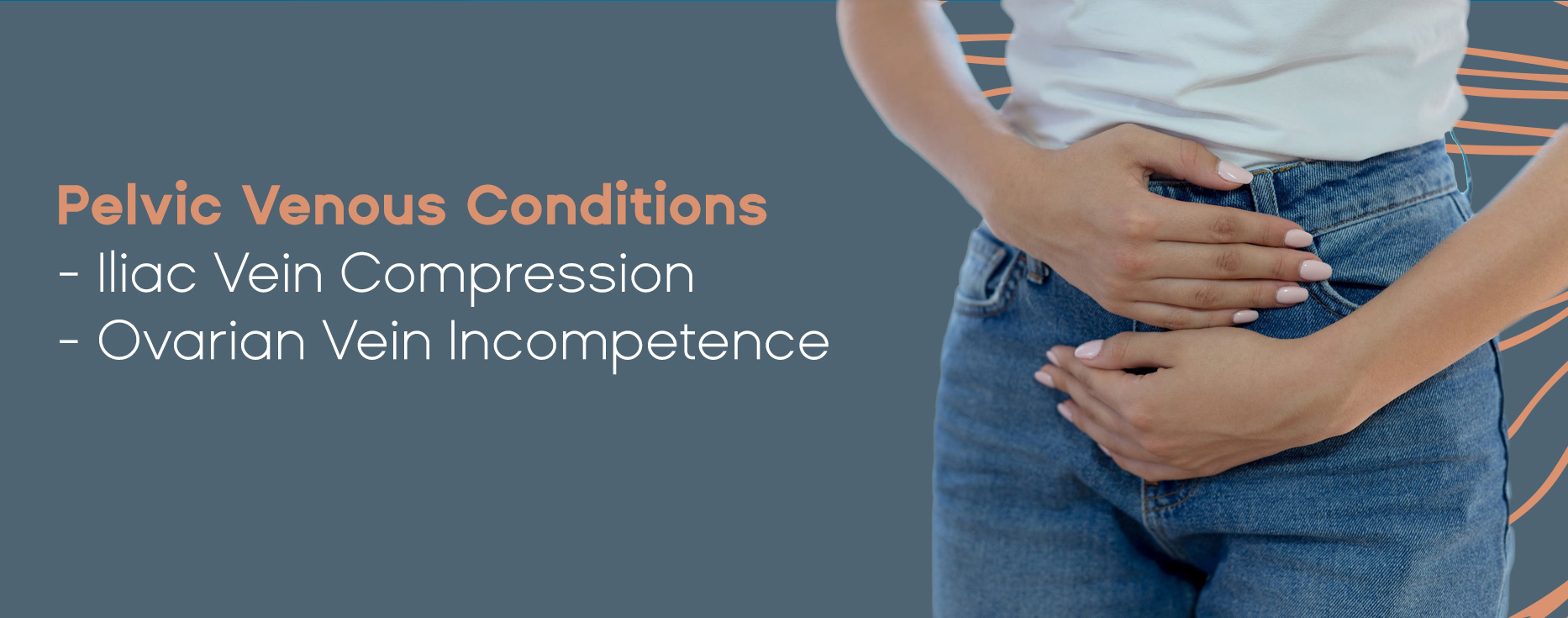Pelvic Venous Disorder


What is Pelvic Venous Disorder?
Pelvic Venous Disorder previously also referred to as Pelvic Venous Compression, Pelvic Venous Insufficiency and Pelvic Congestion Syndome is caused by the compression or squashing of the pelvic veins.
It can be due to a number of causes including Iliac Vein Compression and Ovarian Vein Incompetence.
What is Iliac Vein Compression?
Iliac Vein Compression describes a condition where the left (and sometimes the right) common iliac vein is compressed (squashed) between the right common iliac artery and the spine.
It is an anatomical variant and is not inherited or caused by anything one has or has not done.
There is a continuous irritation of the vein by the combination of pulsation by the artery with the compression, and this causes webs of scar tissue to form on the inside of the vein (trabeculae).
They obstruct the flow of blood from the leg and pelvis back to the heart.
It is thought to occur in around 20-25% of people and is more common in women than men.
Not everyone who has MTS will have problems related to it, but the percentage that does have problems is not known.
Up to now, the usual way to make the diagnosis is by a combination of ultrasound and venogram (placing a needle in the vein and injecting dye). This is getting better, but is not the “gold standard”.
The most accurate way to diagnose this condition is by using IVUS.
The condition has been recognised for many years but has been difficult to diagnose easily.
Venous ultrasound is increasingly accurate as long as it is performed by a specially trained technician.
Other diagnostic tools include venogram (placing a needle in the vein in the groin and injecting dye to visualize the iliac veins) and magnetic resonance venography (MRV).
What are the symptoms of Iliac Vein Compression?
Often, it is found as part of investigations for Deep Venous Thrombosis (DVT), but there are symptoms that can be associated with this condition:
- Chronic swelling of the left leg (sometimes both legs)
- Varicose veins, especially if they return after adequate initial treatment, or if the origin of the varicose veins appears to be coming from pelvic venous pathology
- Chronic venous insufficiency, including pigmentation around the ankle, eczema, itching, or ulcers around the ankle
- Heavy menstrual flow
- Heaviness or dragging pain in the pelvis
- Heavy feeling in the legs and thighs or hips
- Back pain
- Pain during intercourse
- Pain or discomfort when passing urine

How can Iliac Vein Compression be treated?
In patients who have a DVT related to Pelvic Venous Disorder, the thrombus (clot) should be removed by a combination of “clot busting” drugs and sucking the clot out (AngioJet). The vein will then need to be held open with a stent.
Where the condition is causing other problems, there is a place for opening the blockage with a combination of balloon and stent.
- Ovarian Vein Incompetence is a significant cause of pelvic discomfort. Pelvic pain impacts 30% of women in their lifetime, and chronic pelvic pain impacts 15% of women.
- The ovarian vein has valves which should allow flow only in one direction and that direction is from the pelvis up towards the chest.
- In some women, these veins are malfunctioning, and the direction of flow in the ovarian vein goes the wrong way, from the upper abdomen down into the pelvis causing congestion in the veins of the pelvis.
What are the symptoms of Ovarian Vein Incompetence?
Symptoms of OVI include:
- Pain is often relieved when the patient lies down
- Heavy menstrual flow
- Heaviness or dragging pain in the pelvis
- Heavy feeling in the legs and thighs or hips; back pain
- Pain on intercourse (dyspareunia)
- Pain or discomfort when passing urine
- It is also worth noting that some women with OVI show signs of visible varicose veins.
- Remember, pelvic pain can have many underlying causes so it is also important to rule out endometriosis, uterine abnormalities, pelvic inflammatory adhesions and other gynaecological issues with your doctor, should pain persist.
- Once these have been ruled out, it is a good option to see a vascular surgeon.
- The risk of chronic pelvic pain having a vascular issue is typically increased with subsequent pregnancies and multiple pregnancies.
- This is because during pregnancy blood vessels expand to accommodate increased blood flow. In turn, this expansion can sometimes cause the valves to malfunction and blood to pool back into the veins, causing painful, varicose veins and ultimately PVC.
- Dr Huber uses state-of-the-art imaging protocols such as ultrasound to help make a diagnosis.
- Other diagnostic tools include venogram, magnetic resonance venography and intravascular ultrasound.
Signs of congestion related to ovarian vein incompetence include:
- Chronic swelling of the left leg (sometimes both)
- Varicose veins especially if they return after adequate initial treatment
What is the treatment for Ovarian Vein Incompetence?
- Blocking the vein using coils prevents the transmission of pressure and decreases the congestion of the veins in the pelvis.
- Find out more about the highly effective hospital day treatment our vascular surgeons perform for Ovarian Vein Incompetence here.
Download an information sheet here
